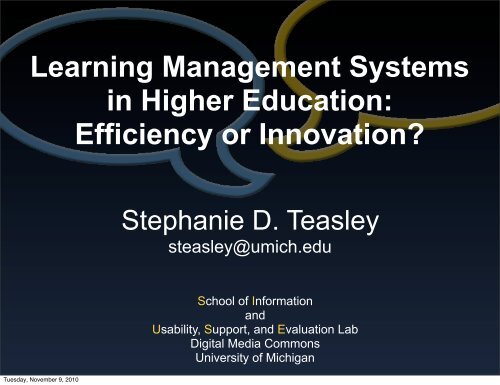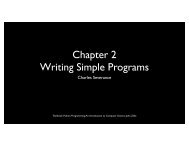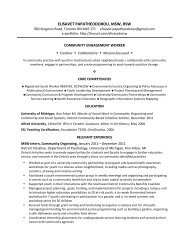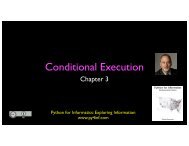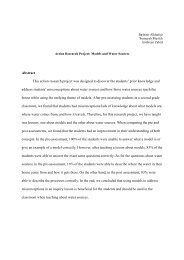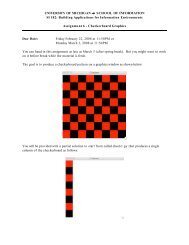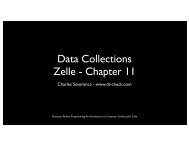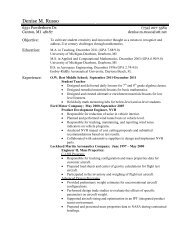Learning Management Systems in Higher Education ... - CTools
Learning Management Systems in Higher Education ... - CTools
Learning Management Systems in Higher Education ... - CTools
- No tags were found...
Create successful ePaper yourself
Turn your PDF publications into a flip-book with our unique Google optimized e-Paper software.
<strong>Learn<strong>in</strong>g</strong> <strong>Management</strong> <strong>Systems</strong><strong>in</strong> <strong>Higher</strong> <strong>Education</strong>:Efficiency or Innovation?Stephanie D. Teasleysteasley@umich.eduSchool of InformationandUsability, Support, and Evaluation LabDigital Media CommonsUniversity of MichiganTuesday, November 9, 2010
Overview• <strong>Learn<strong>in</strong>g</strong> management systems (LMS)are ubiquitous <strong>in</strong> higher education andgrow<strong>in</strong>g <strong>in</strong> primary & secondary.• Are there <strong>in</strong>novations <strong>in</strong> <strong>in</strong>structors' useof LMS? What can LMS offer to thevision of future learn<strong>in</strong>g spaces?• We used the lens of <strong>in</strong>teraction to typifyLMS perceptions and use.SI & USE LabUniversity of MichiganTuesday, November 9, 2010
USE LabResearch Team• Steven Lonn• Tanya Cleveland Solomon• Andrew E. Krumm• Kara Makara• Diana Perpich• Pablo Qu<strong>in</strong>ones• Chan ZhangSI & USE LabUniversity of MichiganTuesday, November 9, 2010
LMS GrowthSI & USE LabUniversity of MichiganTuesday, November 9, 2010
LMS GrowthSI & USE LabUniversity of MichiganTuesday, November 9, 2010
LMS GrowthSI & USE LabUniversity of MichiganTuesday, November 9, 2010
Different Types ofInteractions• Different <strong>in</strong>teraction types can lead todifferent learn<strong>in</strong>g outcomes(e.g., Bernard et al, 2009)• Learner-Content (LC)• Learner-Instructor (LI)• Learner-Learner (LL)• (see Moore, 1989)SI & USE LabUniversity of MichiganTuesday, November 9, 2010
Perceptions of LMSUse Across Institutions• Surveyed <strong>in</strong>structors' andstudents' perception ofvalue of LMS activitiesacross 11 Americanuniversities• Instructors (N = 2,570)• Students (N = 6,980)Tuesday, November 9, 2010SI & USE LabUniversity of Michigan
Survey Items by Interaction TypeTuesday, November 9, 2010SI & USE LabUniversity of Michigan
Survey Items by Interaction Type• Learner-Content (LC)• Post / Access onl<strong>in</strong>e read<strong>in</strong>gs & supplementarymaterials• Post / Access lecture outl<strong>in</strong>e before lecture• Post / Access lecture outl<strong>in</strong>e after lecture• Post / Access multimedia materialsTuesday, November 9, 2010SI & USE LabUniversity of Michigan
Survey Items by Interaction Type• Learner-Content (LC)• Post / Access onl<strong>in</strong>e read<strong>in</strong>gs & supplementarymaterials• Post / Access lecture outl<strong>in</strong>e before lecture• Post / Access lecture outl<strong>in</strong>e after lecture• Post / Access multimedia materials• Learner-Instructor (LI)• Send / Receive messages or notifications• Students turn <strong>in</strong> assignments• Instructors return assignments with commentsand/or grades• Students ask questions before lectureStudents ask questions after lectureGive / Take onl<strong>in</strong>e exams and quizzes• Post / Access course or assignment gradesTuesday, November 9, 2010SI & USE LabUniversity of Michigan
Survey Items by Interaction Type• Learner-Content (LC)• Post / Access onl<strong>in</strong>e read<strong>in</strong>gs & supplementarymaterials• Post / Access lecture outl<strong>in</strong>e before lecture• Post / Access lecture outl<strong>in</strong>e after lecture• Post / Access multimedia materials• Learner-Instructor (LI)• Send / Receive messages or notifications• Students turn <strong>in</strong> assignments• Instructors return assignments with commentsand/or grades• Students ask questions before lectureStudents ask questions after lectureGive / Take onl<strong>in</strong>e exams and quizzes• Post / Access course or assignment grades• Learner-Learner (LL)Students work together on a task or assignmentStudents read / comment on each others' workStudents generate / share <strong>in</strong>structional materials• Instructors create / Students are part of ad-hocstudent groups or teamsSI & USE LabUniversity of MichiganTuesday, November 9, 2010
Multi-InstitutionalResearch Questions• Do respondents' values of <strong>in</strong>teraction typesdiffer between• <strong>in</strong>structors and students• university sett<strong>in</strong>gs (research / non-research)• number of courses us<strong>in</strong>g LMS, and/or• use/preference of IT <strong>in</strong> courses?Tuesday, November 9, 2010SI & USE LabUniversity of Michigan
Factors Affect<strong>in</strong>gInteractionIndependent Variables:• Instructor/student (RQ #1)• Research/Non-research university (RQ #2)• Number of courses one has used an LMS (RQ #3)• Use / Preference for IT (RQ #4)Tuesday, November 9, 2010SI & USE LabUniversity of Michigan
F<strong>in</strong>d<strong>in</strong>gs• Learner-Content (LC)• Students value slightly more than <strong>in</strong>structors• <strong>Higher</strong> use of LMS = More value for LC activities• Learner-Instructor (LI)• Students value much more than <strong>in</strong>structors• Learner-Learner (LL)• Non-research <strong>in</strong>stitutions value more than Research<strong>in</strong>stitutions• <strong>Higher</strong> use of LMS = Less value for LC activities• Use / Preference for IT = More value for all <strong>in</strong>teraction typesTuesday, November 9, 2010SI & USE LabUniversity of Michigan
Residential vs.Commuter• Look at trends frommulti-<strong>in</strong>stitutional study<strong>in</strong> more detail byfocus<strong>in</strong>g on just twocampuses.• Also allowed us tolook at user log filesand qualitative data.SI & USE LabUniversity of MichiganTuesday, November 9, 2010
Residential vs.Commuter• Instructors: 612 residential; 64 commuter• Undergraduate students: 1,182 residential;805 commuter• Research questions:• Campus differences• Instructor vs. Student perceptions• How do user logs compare with surveyperceptions?SI & USE LabUniversity of MichiganTuesday, November 9, 2010
General Trends• No differences for <strong>in</strong>structors between campuses• Residential students rate most Learner-ContentLMS activities higher than commuter students.• Commuter students rate some Learner-Instructorand nearly all Learner-Learner LMS activitieshigher than residential students.Tuesday, November 9, 2010SI & USE LabUniversity of Michigan
User Log DifferencesBetween Campuses• 1,565 residential campus LMS sites287 commuter campus LMS sites• Aggregated all events by tool for coursesites <strong>in</strong> which student respondents wereenrolled.• Categorized tools by LC, LI, LL• Differences of average percentage ofuse across LMS sites by campus.Tuesday, November 9, 2010SI & USE LabUniversity of Michigan
Tool Use DifferencesBetween CampusesCategoryToolResidentialCampusCommuterCampusMeanDifferenceLearner-ContentLearner-InstructorContent Shar<strong>in</strong>g 57.7% 52.4% 5.3Drop Box 4.8% 2.6% 2.2Email Archive 0.5% 0.1% 0.4Chat 0.8% 1.7% 0.9Learner-LearnerDiscussion 1.3% 3.0% 1.7Forums 0.6% 2.9% 2.3Messages 2.9% 6.2% 3.3SI & USE LabUniversity of MichiganTuesday, November 9, 2010
Summary• No significant differences for <strong>in</strong>structorperceptions between campuses• Residential students rated & usedLearner-Content activities / tools higherthan commuter students• Commuter students rated & usedLearner-Learner activities / tools higherthan commuter studentsSI & USE LabUniversity of MichiganTuesday, November 9, 2010
How Does LMS AffectUse of In-Class Time?• Open-Ended Survey Item:• "Has us<strong>in</strong>g the LMS affected how you/your<strong>in</strong>structors use <strong>in</strong>-class time? If so, how?"• Item Sample:• Residential campus students (n=1,101)• Residential campus <strong>in</strong>structors (n=602)• Commuter campus students (n=682)• Commuter campus <strong>in</strong>structors (n=55)Tuesday, November 9, 2010SI & USE LabUniversity of Michigan
How Does LMS AffectUse of In-Class Time?CodeResidential CampusCommuter CampusStudents Instructors Students InstructorsFacilitates logistics 22% 19% 15% 22%Provides access to materials 18% 17% 16% 29%General positive response 9% 7% 12% 11%Changes the content/pace of <strong>in</strong>struction 7% 4% 12% 2%Facilitates discussion <strong>in</strong> class or onl<strong>in</strong>e 2% 3% 3% 6%Preparation for class - students 1% 2% 3% 2%Limited / non-user 1% 1% 3% 0%Does not change 34% 40% 27% 26%Changes negatively 3% 2% 4% 2%SI & USE LabUniversity of MichiganTuesday, November 9, 2010
How Does LMS AffectUse of In-Class Time?CodeResidential CampusCommuter CampusStudents Instructors Students InstructorsFacilitates logistics 22% 19% 15% 22%Provides access to materials 18% 17% 16% 29%General positive response 9% 7% 12% 11%Changes the content/pace of <strong>in</strong>struction 7% 4% 12% 2%Facilitates discussion <strong>in</strong> class or onl<strong>in</strong>e 2% 3% 3% 6%Preparation for class - students 1% 2% 3% 2%Limited / non-user 1% 1% 3% 0%Does not change 34% 40% 27% 26%Changes negatively 3% 2% 4% 2%SI & USE LabUniversity of MichiganTuesday, November 9, 2010
Learner-Content(LC) InteractionsStudents• "I th<strong>in</strong>k LMS makes my <strong>in</strong>structors more efficient becausethey do not have to worry about always mak<strong>in</strong>gannouncements <strong>in</strong> class. LMS keeps the entire class upto date and <strong>in</strong>formed."• "They can use documents posted <strong>in</strong> LMS <strong>in</strong> lectures, andreference read<strong>in</strong>g to make po<strong>in</strong>t relat<strong>in</strong>g the subject."• "Yes, it makes it easier for us to review lectures andread<strong>in</strong>gs ahead of time. It is easy for the prof to send usnotifications."SI & USE LabUniversity of MichiganTuesday, November 9, 2010
Learner-Content(LC) InteractionsInstructors• "Cuts down on the need for spend<strong>in</strong>g time on'class bus<strong>in</strong>ess' e.g. announcements etc."• "It saves me time from direct<strong>in</strong>g them to certa<strong>in</strong>websites, and when I am asked a specificquestion that requires a very long response, I amable to let learners know that I will post moreresources to LMS by the end of the even<strong>in</strong>g."• "I ask learners to review lecture notes beforeclass so we can spend more class time onactivities."SI & USE LabUniversity of MichiganTuesday, November 9, 2010
Other InteractionsStudents• "Many questions that learners ask are answered onLMS. This makes fore more efficient use of classtime." (LI)• "Well yes, usually what we cannot get done or talk about<strong>in</strong> class, she posts a discussion topic on l<strong>in</strong>e." (LL)Instructors• "In some classes, discussion & group learn<strong>in</strong>g canhappen onl<strong>in</strong>e between classes, extend<strong>in</strong>g the types ofactivities we do <strong>in</strong>-class to time outside of class." (LL)SI & USE LabUniversity of MichiganTuesday, November 9, 2010
Negative Responses• Instructors saw the LMS as not be<strong>in</strong>g used bystudents, negatively affect<strong>in</strong>g students behavior,reduc<strong>in</strong>g <strong>in</strong>teraction, and cited technologicalproblems:"Students use access to LMS as an excuse forskipp<strong>in</strong>g lectures."SI & USE LabUniversity of MichiganTuesday, November 9, 2010
Negative Responses• Students ma<strong>in</strong>ly blamed <strong>in</strong>structors' <strong>in</strong>efficienciesfor the negative effects of the LMS on <strong>in</strong>-classtime:"The only side effect of this centralization is thatmy <strong>in</strong>structors have tended to assume thatlearners are familiar with LMS, that it doesn'tneed to be expla<strong>in</strong>ed, and that any problemsrelated to LMS are the user's (i.e. the learner's)fault."SI & USE LabUniversity of MichiganTuesday, November 9, 2010
Qualitative Analysis Summary• Facilitates <strong>in</strong>-class learner-content <strong>in</strong>teraction,whereas learner-learner and learner-<strong>in</strong>structor<strong>in</strong>teraction was cited much less frequently• Few differences between campus types• Residential most popular response: facilitates logistics• Commuter most popular response: access to materials• Residential: 59% positive; Commuter: 69% positiveSI & USE LabUniversity of MichiganTuesday, November 9, 2010
Qualitative Analysis Summary• Facilitates <strong>in</strong>-class learner-content <strong>in</strong>teraction,whereas learner-learner and learner-<strong>in</strong>structor<strong>in</strong>teraction was cited much less frequently• Few differences between campus types• Residential most popular response: facilitates logistics• Commuter most popular response: access to materials• Residential: 59% positive; Commuter: 69% positive• Differences between <strong>in</strong>structors and students <strong>in</strong>how they perceive LMS affect on class time• Students saw problems where <strong>in</strong>structors didnot, e.g., "They move too quickly over slides asthey will be posted later to LMS"SI & USE LabUniversity of MichiganTuesday, November 9, 2010
Examples of LMS Use• Community Health Nurs<strong>in</strong>g• Instructor sought materials for data &policy and stories of served populations.• Used case-based characters from"The Neighborhood" onl<strong>in</strong>e resource.• Instructor presents the content <strong>in</strong>comb<strong>in</strong>ation with the LMS tools.• Uses LMS to l<strong>in</strong>k to scholarly articles & newsstories• She posts notifications & rem<strong>in</strong>ders and usesassessment tools for rapid feedback.SI & USE LabUniversity of MichiganTuesday, November 9, 2010
Examples of LMS Use• Pr<strong>in</strong>ciples of Eng<strong>in</strong>eer<strong>in</strong>g Materials• Introductory course - weekly lecture& discussion section with teach<strong>in</strong>g assistant.• Instructor sought way to directly engage studentsand share his approach to weekly problem-solv<strong>in</strong>gassignments.• LiveScribe system purchased to record<strong>in</strong>structors' solutions to homework problems.• Shares "pencasts" of solutions via LMS.• Uses LMS to answer questions dur<strong>in</strong>g lecture.• Meets students on familiar ground (the LMS) whilealso utiliz<strong>in</strong>g unfamiliar engagement technologiesto assist learner-<strong>in</strong>structor <strong>in</strong>teraction.SI & USE LabUniversity of MichiganTuesday, November 9, 2010
Examples of LMS Use•Jazz Arrang<strong>in</strong>g• Students share orig<strong>in</strong>al compositions witheach other & for credit.• Students used to have to perform live orrecord outside of class.•Instructor experimented with Sibelius.• Compositions archived digitally & filesplay themselves: focus is on thecomposition, not the performer.• LMS Assignments tool used to collectcompositions & grade privately.• Other LMS tools used to manage logistics.SI & USE LabUniversity of MichiganTuesday, November 9, 2010
LectureTools• Hybrid for LC, LI, LL• Students take notes onl<strong>in</strong>e- synchronized to lectureslides• Instructors ask studentsquestions dur<strong>in</strong>g & afterlecture• Students can answer each others' questions &view seat map to create groups for projects.• Next version: cloud tags of students' notes - whatare students' f<strong>in</strong>d<strong>in</strong>g most salient <strong>in</strong> lecture?SI & USE LabUniversity of MichiganTuesday, November 9, 2010
Student-Created Sites• Over 60% of "project sites" created bystudents• 70% for group projects• When students drive use, potential for<strong>in</strong>novative and collaborative approaches toLMS tools• Support<strong>in</strong>g student-generated, studentsubscribed,student-customized workTuesday, November 9, 2010SI & USE LabUniversity of Michigan
Conclusions• Across campuses, LMS are seen and used by<strong>in</strong>structors & students today for ma<strong>in</strong>lysupport<strong>in</strong>g learner-content <strong>in</strong>teraction.• Very few courses use the learner-learneroriented tools.• All activities rated highly. Some rated morehighly by students compared to <strong>in</strong>structors.• <strong>Higher</strong> rat<strong>in</strong>gs for users with more LMSexperience and greater preference for IT <strong>in</strong>teach<strong>in</strong>g and learn<strong>in</strong>g.Tuesday, November 9, 2010SI & USE LabUniversity of Michigan
However...• There are <strong>in</strong>dications that LMS isaffect<strong>in</strong>g <strong>in</strong>-class time and thereare grow<strong>in</strong>g examples of coursesus<strong>in</strong>g LMS to maximize learner<strong>in</strong>structorand learner-learner<strong>in</strong>teractions, as well as richerlearner-content <strong>in</strong>teractions.SI & USE LabUniversity of MichiganTuesday, November 9, 2010
Future <strong>Learn<strong>in</strong>g</strong>Spaces with LMS• As seen <strong>in</strong> examples, <strong>in</strong>structors are"mash<strong>in</strong>g up" external technologies withLMS (Severance et al., 2008).• As Web 2.0 matures, cont<strong>in</strong>uedmash<strong>in</strong>g <strong>in</strong> order to maximize LI & LL<strong>in</strong>teractions.• LMS as portal, central, familiar onl<strong>in</strong>espace where learn<strong>in</strong>g beg<strong>in</strong>s and isfacilitated by the <strong>in</strong>structor.SI & USE LabUniversity of MichiganTuesday, November 9, 2010
Thank YouStephanie D. Teasleysteasley@umich.eduSchool of InformationandUsability, Support, and Evaluation LabDigital Media CommonsUniversity of MichiganSI & USE LabUniversity of MichiganTuesday, November 9, 2010


